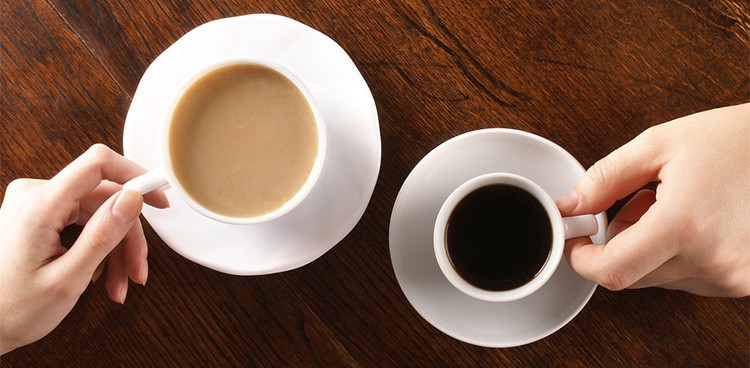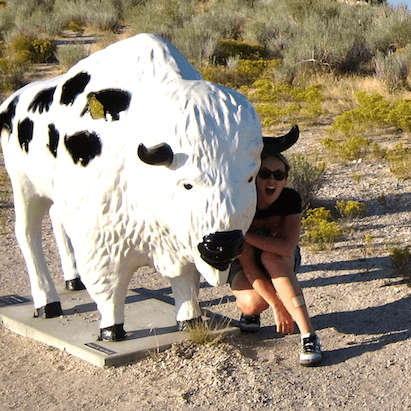
Cheese and… coffee? It’s not as crazy as it sounds. As anyone who’s sipped a piping brew between bites of ricotta cheesecake or a mascarpone-stuffed confection can tell you, coffee and cheese can sing, sing, sing.
“You put cream in coffee, so why not put coffee on cream?” says Beehive Cheese co-founder Pat Ford. Such was the rationale behind the company’s signature Barely Buzzed, a creamy Irish-style aged cheddar made with Jersey cow’s milk and rubbed with crushed espresso beans and fragrant lavender buds.
“When we first introduced it here in Utah—a pretty conservative state—[people] turned up their noses,” Ford says of the 2005 debut. “Then they tasted it and said, Oh, my gosh! That’s really good!” (There’s proof in Washington, D.C., where Barely Buzzed stars in the best-selling grilled sandwich from The Big Cheese food truck.)
Coffee and cheese are a natural match, because many of the nuances found in roasted coffee beans—nuts, caramel, chocolate, flowers, fruit—are also found in cheese. As with a wine or beer pairing, neither coffee nor cheese should overpower the other. Mild roasts complement easygoing cheeses; deeper roasts bond with more assertive cheeses. In general, milky, creamy, fatty varieties play well—especially with earthy Indonesian coffees or fruity, citrusy Ethiopians, which recall classic cheese accoutrements such as jam and stone fruit.
“Find similarities or contrasts,” says Will Frischkorn, co-owner of Cured, a gourmet shop that shares walls with Boxcar Coffee Roasters in Boulder, Colo. The butterscotch sweetness of aged gouda frolics with toasty coffees; the bite of slightly sharp cheddar matches medium roasts and espresso. Funkier cheeses find comfort with coffees boasting bold notes.
Not surprisingly, eating blue cheese with java is a universal no-no. “Any cheese with the slightest acidity [doesn’t] work with coffee,” says Neal Corl, chef-in-residence at Ristretto Roasters in Portland, Ore., of a recent coffee-plus-cheese event. “Even buffalo mozzarella seems too acidic.”
Unlike happy hour beverages, coffee adds a unique dimension: temperature contrast. Pop a piece of cheese, sip hot Joe, and savor a textural transformation. Oh, yeah, we melt with you.
How to Taste
First, make sure that the coffee is not going to be so blisteringly hot that you’ll burn yourself if you take a big sip. “I always tell people to take a bite of the cheese first and start chewing,” says Andrea Robinson, a coffee pro (and sommelier) who represents Nespresso. “Then, as you’re starting to swallow, take a sip of the coffee. As you take that sip, you get the interplay of textures and flavors on your palate, and you’re getting a shared finish of aromatics and taste profiles from both the coffee and the cheese.” Avoid using milk, cream, or sugar in the coffee, which can obscure natural flavors and aromas.

A Beehive Cheese Co. employees hand-rubs a wheel of Barely Buzzed with ground coffee, lavender, and canola oil.
Easy
Try the cheese that some say started the trend: Beehive Cheese’s Barely Buzzed. Other cheese styles showcasing creamy, milky sweetness, such as soft, young gouda or triple crèmes, ease taste buds into coffee pairings, says Rocco Rainone, an American Cheese Society Certified Cheese Professional and manager of Di Bruno Brothers’ Ninth Street location in Philadelphia, which hosts a weekly Sunday Breakfast Club coffee-cheese tasting. He chooses house blends for novice drinkers. “They offer a little bit of everything on the taste spectrum to appeal to a wide audience. They’re also not as expensive as single varietals.”
Beehive Cheese Co. Barely Buzzed + Boxcar Coffee Roasters Stella Espresso
Cowgirl Creamery Mt. Tam + Counter Culture Coffee Remera
Isle of Mull Cheddar + Stumptown Coffee Roasters House Blend
Extra-Flavorful
When choosing cheeses with added flavors, take a cue from Beecher’s Handmade Cheese—located just a stone’s throw from the original Starbucks in Seattle. In 2008 the shop was asked for a cheese to accompany the chain’s new Pike Place Roast, a chocolaty medium roast. “We all agreed,” says Beecher’s Julie Riendl. “Our No Woman cheese, flavored with Jamaican jerk seasoning, was the best pairing.” Also consider contrasting slightly firmer yet still creamy and rich cheeses with coffees showcasing berry and citrus notes. Cow’s and sheep’s milk cheeses that retain moisture during their make process will highlight even more of the fruity notes in the coffee.
Beecher’s Handmade Cheese No Woman + Starbucks Pike Place Roast
Schmidhauser’s Tomme de Crayeuse + Ristretto Roasters Nicaraguan Maracaturra
Traditional Cheese Dairy Lord of the Hundreds + Sweet Maria’s Sulawesi
Adventurous
Intensity, ahoy! The sharp tang of English-style cheddar against Sumatra’s richness or zippy chèvre with a juicy Colombian brew is not for the faint of palate. Sean Gartrell of Conscious Coffees in Boulder, Colo., enjoys unwashed Ethiopia Yirgacheffe or Sidamo single origins with aged sheep’s milk gouda, as the coffee’s high acidity and citrus notes dance with the sweet cheese, “like a blueberry muffin,” Gartrell says. But it’s no cakewalk for the uninitiated. “Most people just getting into coffee don’t appreciate the nuances of an Ethiopian roast,” he says, “because it’s so unlike what you’re used to.”
Bleu Mont Bandaged Cheddar + Boxcar Coffee Roasters Sumatra
Cheeseland Ewephoria + Conscious Coffees Organic Ethiopia Yirgacheffe
Shellbark Hollow Farm Sharp Chèvre + ReAnimator Coffee Roasters Colombia Gaitania
Quirky-Classic
Mimic the Swedes and make kaffeost: “coffee cheese.” Drop cubes of leipäjuusto (Finnish squeaky cheese traditionally made from “beestings,” the first protein-rich milk from a new mother cow) or fresh cheese curds into a mug. Pour over a mild morning brew, and serve with a side of toast slathered with Cloudberry preserves.
Leipäjuusto + Intelligentsia Coffee El Gallo Organic Breakfast Blend + Hafi Cloudberry Preserves
Feature Photo Credit: “Concept of male and female hands, love and coffee” by Maksim Shmeljov | Shutterstock
Coffee Beans: “coffee beans” by naka-stockphoto | Shutterstock






